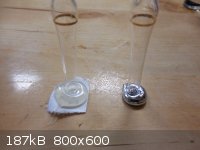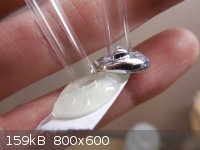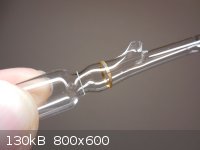MrHomeScientist
International Hazard
    
Posts: 1806
Registered: 24-10-2010
Location: Flerovium
Member Is Offline
Mood: No Mood
|
|
Temporarily Sealing He in Ampoule
I have an interesting problem that I can't quite figure out. I am trying to ampoule helium gas for myself and a fellow collector here, using one of
the high purity cylinders I work with. The plan is to hold the ampoules upside-down, flush with the helium for several minutes to displace all the
air, then flame seal them closed.
The problem is that the lab strongly does not allow open flames or propane use at all, so I can't flame seal the ampoules in the lab where the
cylinders are. So, I need some way to temporarily seal the ampoules until I can get them home to permanently flame seal them. Parafilm, my usual go-to
for this, won't work since it's permeable to He (so I hear from the other lab workers). Any ideas?
|
|
|
elementcollector1
International Hazard
    
Posts: 2684
Registered: 28-12-2011
Location: The Known Universe
Member Is Offline
Mood: Molten
|
|
Hot glue?
Just a thought...
Elements Collected:52/87
Latest Acquired: Cl
Next in Line: Nd
|
|
|
vmelkon
National Hazard
   
Posts: 669
Registered: 25-11-2011
Location: Canada
Member Is Offline
Mood: autoerotic asphyxiation
|
|
Can't you use a rubber stopper?
How about silicone stopper?
You can use silicone but the curing emits acetic acid and is very permeable. However, silicone sticks really well to glass.
How about filling a balloon, taking it home and flushing the ampoule?
Signature ==== Is this my youtube page? https://www.youtube.com/watch?v=tA5PYtul5aU
We must attach the electrodes of knowledge to the nipples of ignorance and give a few good jolts.
Yes my evolutionary friends. We are all homos here. |
|
|
Zyklon-A
International Hazard
    
Posts: 1547
Registered: 26-11-2013
Member Is Offline
Mood: Fluorine radical
|
|
I use hot glue all the time for that doing that. Just put a blob if glue on the tip, then as soon as your ready, apply heat to the center of the
ampule stem. Works like a charm!
BTW, that is also how I keep reactive metals under an inert atmosphere, works the same way.
[Edited on 28-4-2014 by Zyklonb]
|
|
|
thesmug
Hazard to Others
  
Posts: 370
Registered: 17-1-2014
Location: Chicago, Il (USA)
Member Is Offline
Mood: No Mood
|
|
A really crazy idea would be to use indium. It wets glass (sticks) very well and is super soft (it makes crackling sounds when you bend it!).
Good eyes
|
|
|
neptunium
National Hazard
   
Posts: 985
Registered: 12-12-2011
Location: between Uranium and Plutonium
Member Is Offline
|
|
how is he going to get enough indium to seal his ampoule? it melts at 156C maybe with hot oil or something....
|
|
|
MrHomeScientist
International Hazard
    
Posts: 1806
Registered: 24-10-2010
Location: Flerovium
Member Is Offline
Mood: No Mood
|
|
| Quote: | | Can't you use a rubber stopper? |
I can't use stoppers because these are small ampoules, so there isn't any stopper small enough to fit them.
This seems simple and could work. Is there any data about the permeability of hot glue to helium? 
| Quote: | | A really crazy idea would be to use indium. |
In fact I already have plenty of indium! It's in my element collection. Gallium would be even better, with its lower melting point, and I have even
more Ga than In.
That's actually a really neat idea. A solid plug of metal should do the trick, I'd think. And it would just melt out when flame sealing the ampoule.
There's also something very appealing about using one element to seal up another!
Really I want some way where I'm relatively sure the He remains in the ampoule, relatively close to the purity at which it comes out of the cylinder.
I have no way of measuring if the He is actually still in the ampoule when I seal it, so I need a method that gives me at least some confidence the
ampoule actually has He in it.
I could be overcomplicating things here, though, and maybe the (now obvious in hindsight) balloon answer is the way to go...
|
|
|
elementcollector1
International Hazard
    
Posts: 2684
Registered: 28-12-2011
Location: The Known Universe
Member Is Offline
Mood: Molten
|
|
Maybe it would be best to go with indium, as I just had the thought that helium, as small an atom as it is, could be capable of diffusing out of the
hot glue... Then again, maybe not.
MrHomeScientist, if you have some nickel wire and a decent transformer, you could always check thusly: http://images-of-elements.com/power_supply.php#a
Elements Collected:52/87
Latest Acquired: Cl
Next in Line: Nd
|
|
|
Zyklon-A
International Hazard
    
Posts: 1547
Registered: 26-11-2013
Member Is Offline
Mood: Fluorine radical
|
|
How soon after you glue/glue with indium will you be able to permanently seal it? I doubt it will diffuse very much in less than 10 minutes or so.
|
|
|
MrHomeScientist
International Hazard
    
Posts: 1806
Registered: 24-10-2010
Location: Flerovium
Member Is Offline
Mood: No Mood
|
|
EC1: I've seen that before, and actually considered buying a few ampoules and a transformer for just such a thing for my element
display. It ended up being very expensive, unfortunately. I have no experience with high voltage either, so there's that too. Isn't the glow dependent
on the pressure and purity of the gas in the ampoule? Even if it did have some helium in there I'm not sure it would be guaranteed to glow.
Possibly stupid question: In the outreach program I do, my co-host uses a Tesla coil to light up a fluorescent bulb. Might this principle be used to
light an ampoule as pictured in the link above? My guess is no, but I'm not quite sure why.
Zyklonb: I'd have to transport it home first, so somewhere on the order of an hour.
|
|
|
elementcollector1
International Hazard
    
Posts: 2684
Registered: 28-12-2011
Location: The Known Universe
Member Is Offline
Mood: Molten
|
|
I've seen one of those cute little plasma globes used to light up fluorescent lights by touching, so I would imagine it could work. I thought
fluorescents these days worked by ionizing small amounts of mercury, with the phosphorescent dyes used to soften the white light?
Elements Collected:52/87
Latest Acquired: Cl
Next in Line: Nd
|
|
|
vmelkon
National Hazard
   
Posts: 669
Registered: 25-11-2011
Location: Canada
Member Is Offline
Mood: autoerotic asphyxiation
|
|
Quote: Originally posted by elementcollector1  | | I've seen one of those cute little plasma globes used to light up fluorescent lights by touching, so I would imagine it could work. I thought
fluorescents these days worked by ionizing small amounts of mercury, with the phosphorescent dyes used to soften the white light?
|
It is a fluorescent powder, not phosphorescent. Calcium tungstate, probably doped with some things.
Fluorescent tubes contain Hg vapor at very low pressure. Break the tip under water and you see how very little gas it contains.
Signature ==== Is this my youtube page? https://www.youtube.com/watch?v=tA5PYtul5aU
We must attach the electrodes of knowledge to the nipples of ignorance and give a few good jolts.
Yes my evolutionary friends. We are all homos here. |
|
|
vmelkon
National Hazard
   
Posts: 669
Registered: 25-11-2011
Location: Canada
Member Is Offline
Mood: autoerotic asphyxiation
|
|
Quote: Originally posted by MrHomeScientist  | EC1: I've seen that before, and actually considered buying a few ampoules and a transformer for just such a thing for my element
display. It ended up being very expensive, unfortunately. I have no experience with high voltage either, so there's that too. Isn't the glow dependent
on the pressure and purity of the gas in the ampoule? Even if it did have some helium in there I'm not sure it would be guaranteed to glow.
Possibly stupid question: In the outreach program I do, my co-host uses a Tesla coil to light up a fluorescent bulb. Might this principle be used to
light an ampoule as pictured in the link above? My guess is no, but I'm not quite sure why.
Zyklonb: I'd have to transport it home first, so somewhere on the order of an hour. |
I think the gas in the ampoule needs to be under low pressure. I don't know if it will work if the helium is at 1 atm.
Signature ==== Is this my youtube page? https://www.youtube.com/watch?v=tA5PYtul5aU
We must attach the electrodes of knowledge to the nipples of ignorance and give a few good jolts.
Yes my evolutionary friends. We are all homos here. |
|
|
elementcollector1
International Hazard
    
Posts: 2684
Registered: 28-12-2011
Location: The Known Universe
Member Is Offline
Mood: Molten
|
|
Not sure about the pressure - it did mention the ampoules were specially prepared, so I would imagine something unusual went into that.
Any luck so far, MHS?
Elements Collected:52/87
Latest Acquired: Cl
Next in Line: Nd
|
|
|
vmelkon
National Hazard
   
Posts: 669
Registered: 25-11-2011
Location: Canada
Member Is Offline
Mood: autoerotic asphyxiation
|
|
Based on looking at the glow, I would say it is under low pressure. In 1 atm, you would see sharp edges. As you reduce the pressure, the spark gets
wider and more diffuse.
On that note, it is interesting that this http://en.wikipedia.org/wiki/Plasma_ball
operates at nearly 1 atm.
Signature ==== Is this my youtube page? https://www.youtube.com/watch?v=tA5PYtul5aU
We must attach the electrodes of knowledge to the nipples of ignorance and give a few good jolts.
Yes my evolutionary friends. We are all homos here. |
|
|
MrHomeScientist
International Hazard
    
Posts: 1806
Registered: 24-10-2010
Location: Flerovium
Member Is Offline
Mood: No Mood
|
|
Well I finally was able to acquire the helium and tried both methods for temporary sealing - hot glue, and gallium. I first filled each ampoule by
placing it over the gas outlet tube for several minutes at a low flow rate, to displace just about all of the air inside. I then quickly stuck the
open end into a molten blob of glue for one and a molten blob of gallium for the other. Upon cooling these formed very solid seals. I kept everything
upside down during transport to further ensure the helium stayed inside.
 
Notice how the gallium expanded up into the inside of the ampoule after cooling - neat! Gallium is definitely in my top 5 favorite elements 
I had some difficulty flame-sealing these things once I got home. Turns out you shouldn't try flame sealing an ampoule that's completely and firmly
plugged at the end:

Oh, the things that are obvious in retrospect.
I had to peel off the glue and then seal, while keeping the ampoule upside-down. I really shouldn't have lost much He during this process, but I can't
really claim it as chromatographic grade anymore I think.
|
|
|
gdflp
Super Moderator
      
Posts: 1320
Registered: 14-2-2014
Location: NY, USA
Member Is Offline
Mood: Staring at code
|
|
If you have the one with gallium left, just an idea, heat up the tip of a syringe or needle and use that to melt a tiny hole through the gallium small
enough that nothing noticeable can enter the ampoule. Then you can heat it up and flame seal it, the rest of the gallium should melt out, but the
pressure won't crack the glass.
|
|
|
Zyklon-A
International Hazard
    
Posts: 1547
Registered: 26-11-2013
Member Is Offline
Mood: Fluorine radical
|
|
That's not how I do it. I seal it while the glue is still on there. I simply apply the flame to the center (or close to the main body) of the the
stem. With galium it would probably melt too fast, but it's worked everytime with hot glue. What you do is use a pliers to firmly grab the very tip
where the glue is. As the stem gets very hot you twist it until it's seals on it self. You will need both hands for this so use a torch you can set
down.
|
|
|
smaerd
International Hazard
    
Posts: 1262
Registered: 23-1-2010
Member Is Offline
Mood: hmm...
|
|
What about some kind of balloon/condom or similar? You could rubber band the gas inside the ampoule. Then when you go to apply the flame open up the
rubber band so the warm air can expand without issue. I realize both of those suggestions kind of assume that the balloon or condom won't act as a
throttle or membrane which for helium I'm sure it would, probably to a lesser extent then open air if it didn't melt first. Oh dear now I'm thinking
about the Joule-Thomson effect. Think I might go smack my head against the wall for a minute (Just finished physical chemistry 1, I'm sure many people
on this board understand)...
[Edited on 15-5-2014 by smaerd]
|
|
|
MrHomeScientist
International Hazard
    
Posts: 1806
Registered: 24-10-2010
Location: Flerovium
Member Is Offline
Mood: No Mood
|
|
Quote: Originally posted by Zyklonb  | | That's not how I do it. I seal it while the glue is still on there. I simply apply the flame to the center (or close to the main body) of the the
stem. With galium it would probably melt too fast, but it's worked everytime with hot glue. What you do is use a pliers to firmly grab the very tip
where the glue is. As the stem gets very hot you twist it until it's seals on it self. You will need both hands for this so use a torch you can set
down. |
This is exactly what I did, sans the twisting. Heating the ampoule's neck to the point of softening while the gallium plug was still in place caused a
pressure spike inside that blew out a hole right where I was pointing the flame. Amusingly, the helium rushing out extinguished the propane torch
flame!
After that incident, I pried off the glue plug (on a second ampoule) and sealed with it open to the air.
[Edited on 5-15-2014 by MrHomeScientist]
|
|
|
Zyklon-A
International Hazard
    
Posts: 1547
Registered: 26-11-2013
Member Is Offline
Mood: Fluorine radical
|
|
Hmm, that didn't happen with me. Perhaps you could keep the bottom of the ampule in an ice bath to compensate (to a certain degree) the gas expansion.
I used a very small butane pen-torch with a short hot flame. It heats it fast and only on a small area. Perhaps this would help?
[EDIT] I'm pretty sure quite a bit of helium escapes as it diffuses in air faster than all gasses save hydrogen: http://inspirehep.net/record/706624/files/fermilab-conf-05-6...
[Edited on 15-5-2014 by Zyklonb]
|
|
|